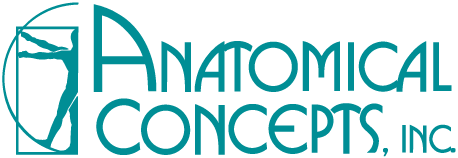![[ACI]-April-Blog-Graphic-v1 (1)](https://www.anatomicalconceptsinc.com/hs-fs/hubfs/%5BACI%5D-April-Blog-Graphic-v1%20(1).jpg?width=1200&name=%5BACI%5D-April-Blog-Graphic-v1%20(1).jpg)
According to the Centers for Disease Control and Prevention, stroke is the third leading cause of death in this country. Someone in the United States has a stroke every 45 seconds.
A stroke typically results in hemiparesis or hemiplegia, when one side of the body is weakened or paralyzed. Stroke is a leading cause of severe and long-term disability in the United States, with 15 to 30 percent of stroke survivors left permanently disabled and 20 percent requiring institutional care three months after onset.
Stroke patients often have a hard road to recovery. In addition to the physical challenges they might face, they may also have difficulty with cognitive and behavioral issues. Dealing with these problems can sometimes make patients’ rehabilitation a frustrating and slow process.
Some common physical challenges patients may experience include:
- Weakness, paralysis, and balance or coordination problems
- Pain, numbness, or burning and tingling sensations
- Foot drop
- Neuro-motor function limitations
- Memory problems, poor attention span, or difficulty solving problems
- Visual problems
- Depression, anxiety, or mood swings
- Difficulty recognizing limitations caused by the stroke
Depending on the damage, many of these limitations or issues can be overcome or improved with time and a customized rehabilitation program. Specifically, foot drop can be treated with physical therapy and assistive devices like knee ankle-foot orthoses (KAFO).
This blog will discuss some of these challenges, including foot drop, and some non-invasive treatment options you should consider for your stroke patients’ successful recovery and rehab.
What is Foot Drop?
The inability to lift the front of the foot is a condition known as Foot Drop. No doubt, some of your patients experience changes in the muscle tone in their legs or feet following a stroke. This change can cause a decrease in coordination or strength, which results in the inability to flex the ankle or lift the forefoot.
This causes your patient to drag their toes when walking or lift the knee higher to compensate for the foot. This can happen in one or both feet, but through rehabilitation, patients can often make partial or complete recoveries.
Stroke survivors experiencing foot drop should begin rehabilitation immediately to fast track recovery. If the condition is not treated, it could result in permanent gait abnormalities, postural deformities, increased fall risk, and further damage to the foot or leg.
The most effective treatment plans include patients wearing an assistive device like knee ankle-foot orthoses (KAFO). This brace will reduce the risk of falling, help maintain foot dorsiflexion, and prevent the foot from inverting while walking.
The brace’s benefits will supplement patients’ experience through other rehabilitation efforts like physical therapy and electrical stimulation.
Why are Orthoses So Important?
For recovering stroke patients, maintaining proper alignment and controlling motion are crucial to resolving instabilities present in the lower extremities. Lower limb orthotic systems like Ankle Foot Orthoses (AFOs) and KAFOs provide the support and alignment needed to improve standing and walking.
Since patients’ statuses fluctuate and each case is different, an orthosis should be adaptable to their changes regardless of whether they are ambulatory or at rest.
When prescribing and fitting an orthosis on a patient, consider factors. These include the type of deformity, the biomechanical deficit to be addressed, an individual’s weight and activity level, and lifestyle issues.
How a KAFO Can Help Recovery
A KAFO is an entire leg brace customized to the specific needs of a patient. The device spans the length of the knee, ankle, and foot to support the muscles, stabilize the joints and assist in safe walking.
Our KAFO is a versatile device that is essential, particularly in the early stages of neurological rehabilitation patient management. Studies have confirmed the value of early mobilization.
Our KAFO is designed to:
- Reduce joint pain
• Improve joint alignment
• Prevent excess joint movement
• Control joint instability
It allows for superior mobility and comfort with a comfortable fit, providing better limb control. Our KAFO is manufactured using thermoplastics or carbon fiber composites, is lightweight and offers a good fit.
Each component, including the knee joint, locking mechanism, pads, and the need for frontal plane control, is determined by a patient’s specific condition.
Historically, the best option to treat lower extremities with an orthosis would be to wear a KAFO with a locked knee joint. This approach did provide the necessary stability and support of the knee to prevent involuntary flexion.
However, it could sometimes cause other issues like muscle atrophy and increased energy expenditure in gait.
Current KAFO technology is re-engineered with an innovative design that can automatically lock and unlock at the necessary times in the gait cycle, which allows for a more fluid walking style.
KAFO Care Recommendations
While your patient wears their KAFO, we recommend that they wear socks. Socks or even tights create a barrier between the brace and skin to prevent friction that may be applied and improve comfort when perspiration occurs.
We suggest that your patients wear a basic athletic shoe with laces or Velcro closures. This allows for easy adjustments if needed.
Each time the KAFO is removed, the patient should check their skin for signs of marking or redness. If red marks remain for longer than 30 minutes or the skin breaks down or blisters, the patient should discontinue the use of the brace and talk to their doctor.
 330-757-3569
330-757-3569




